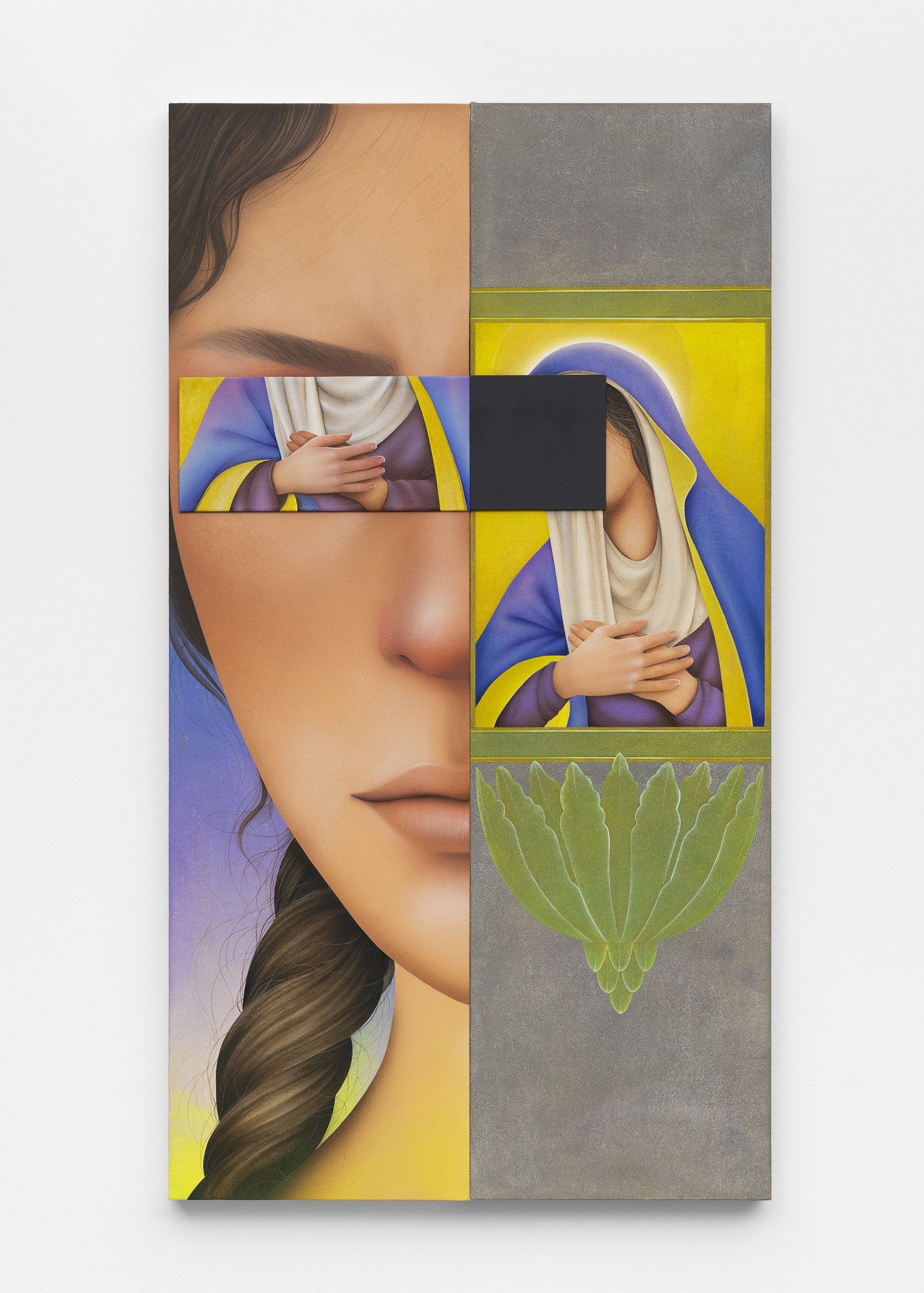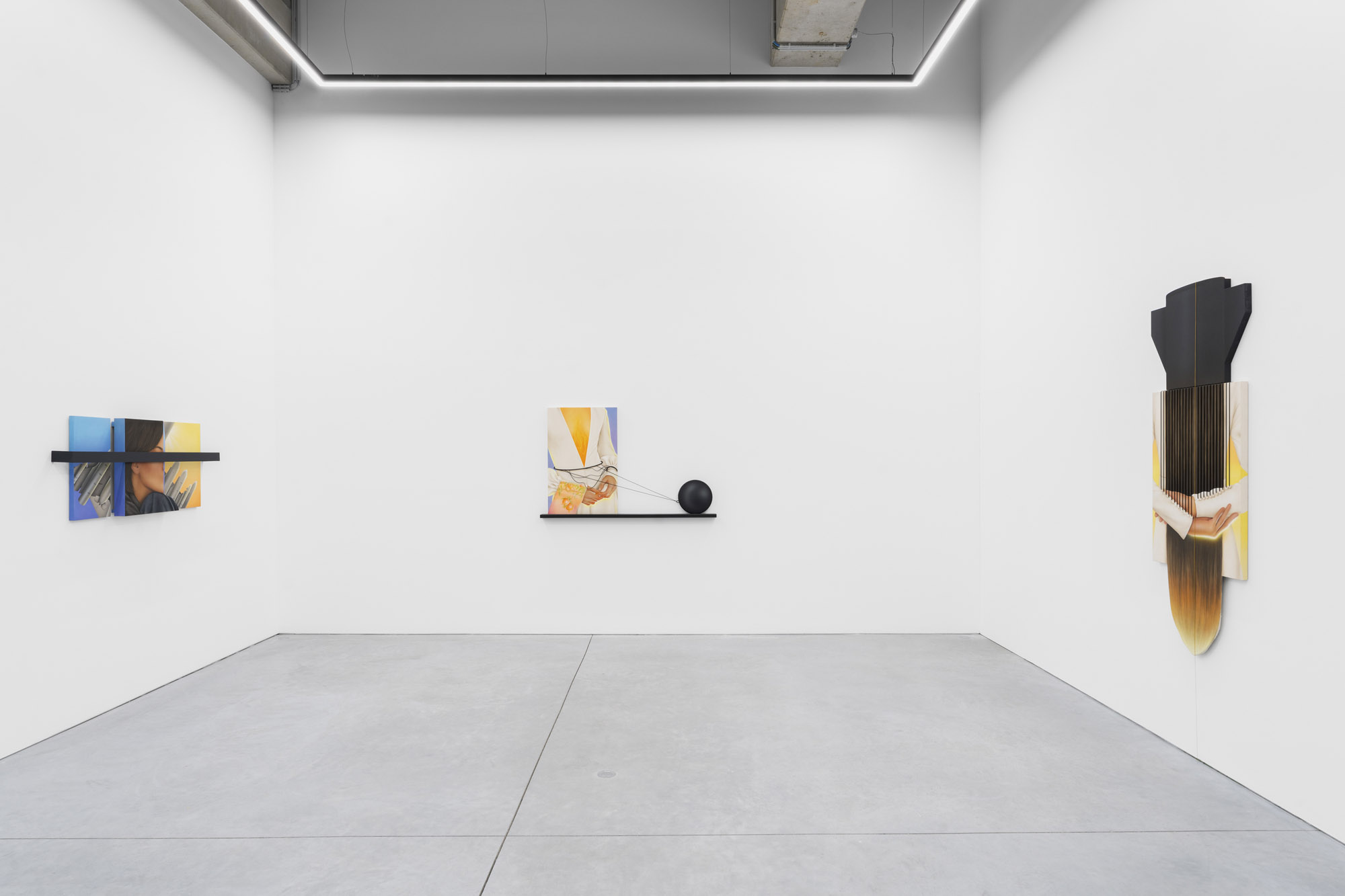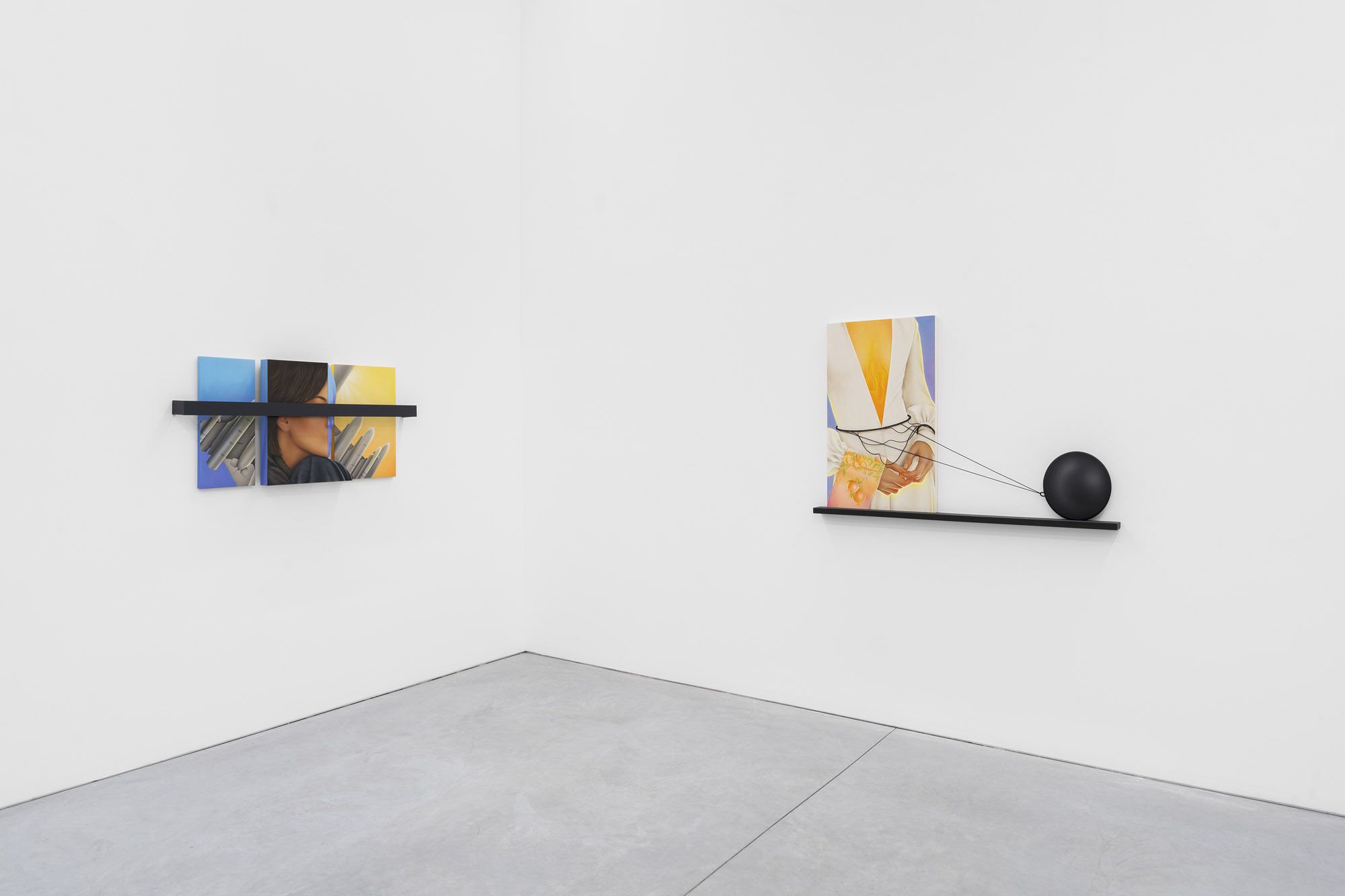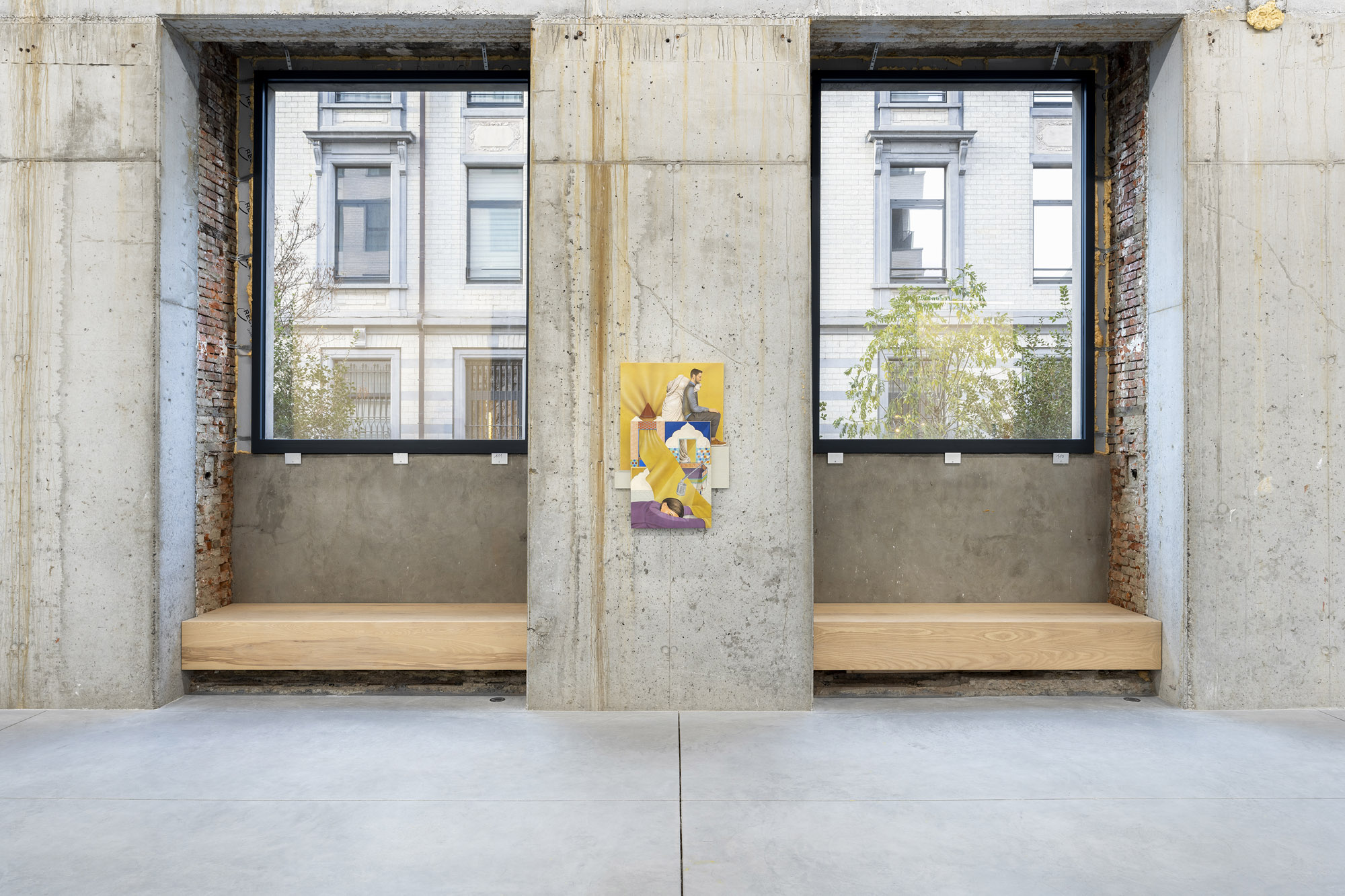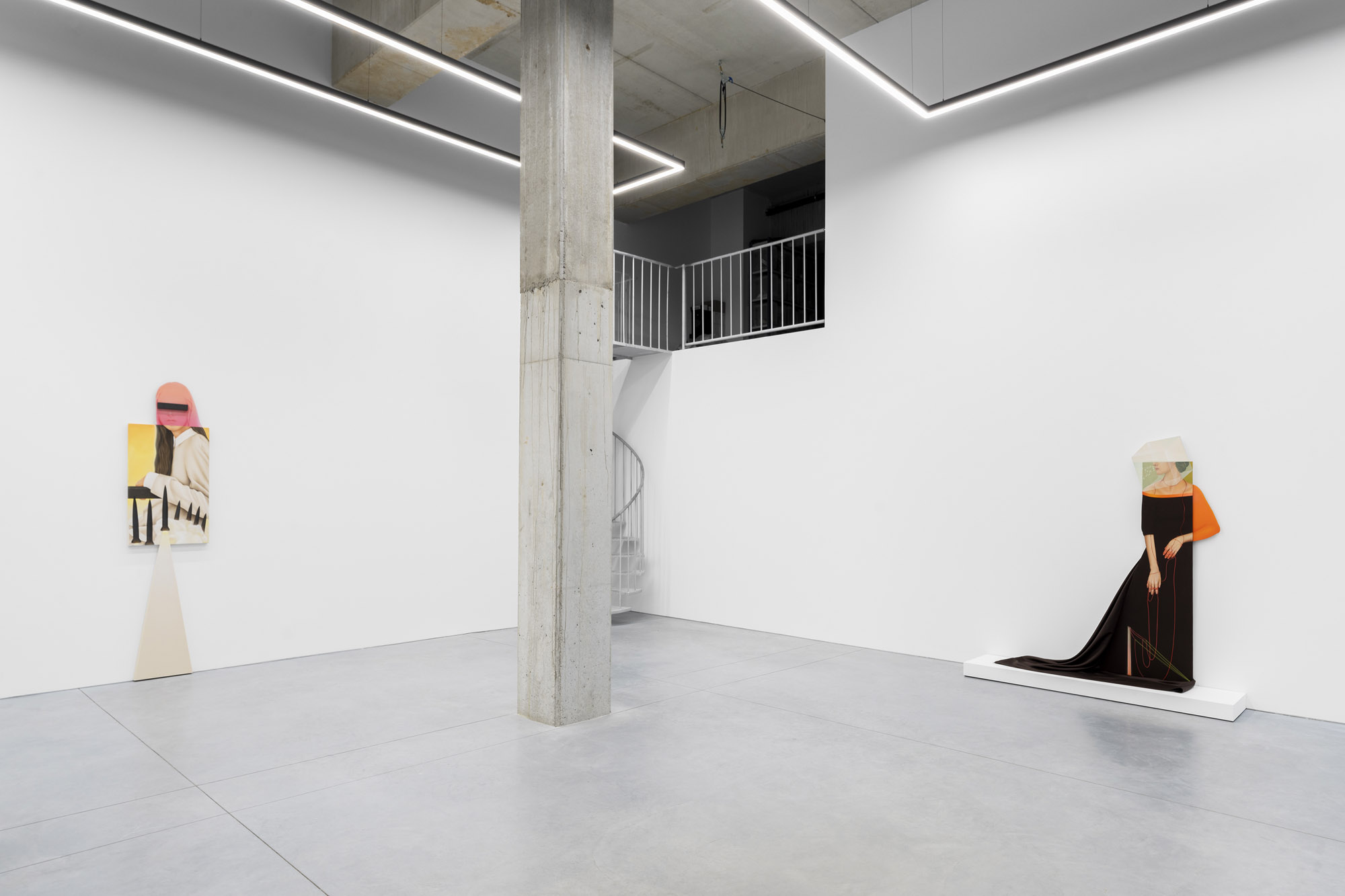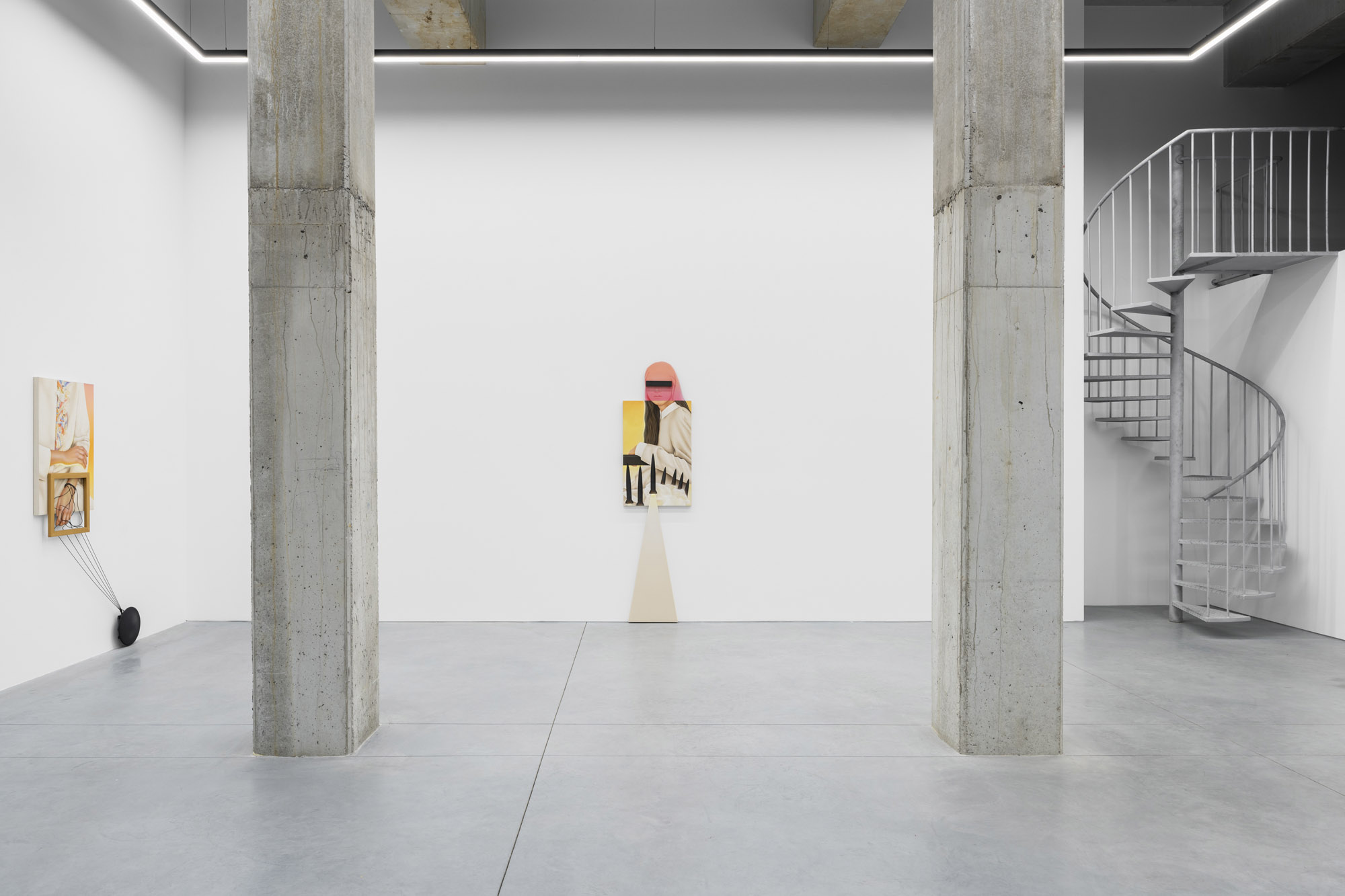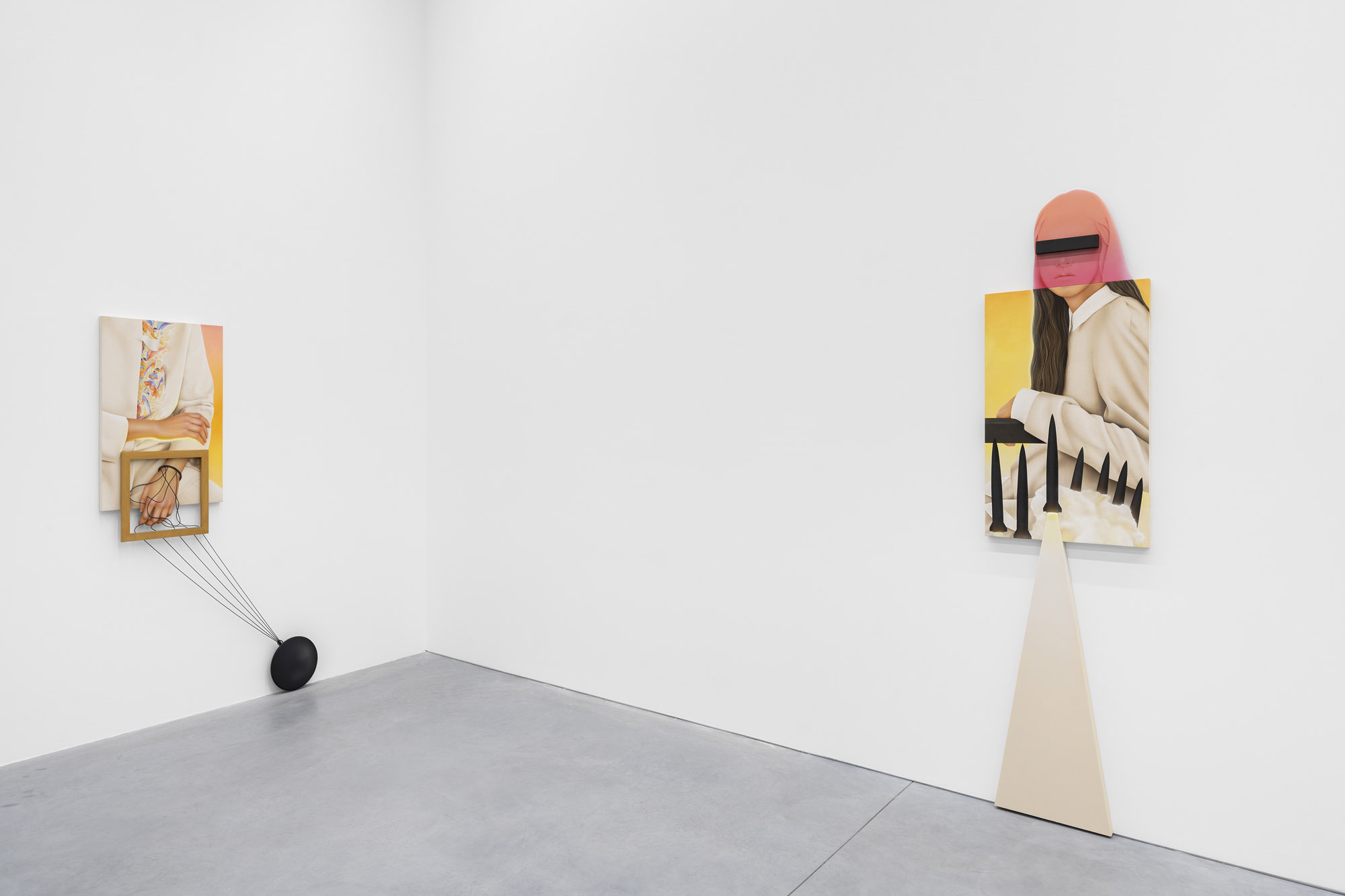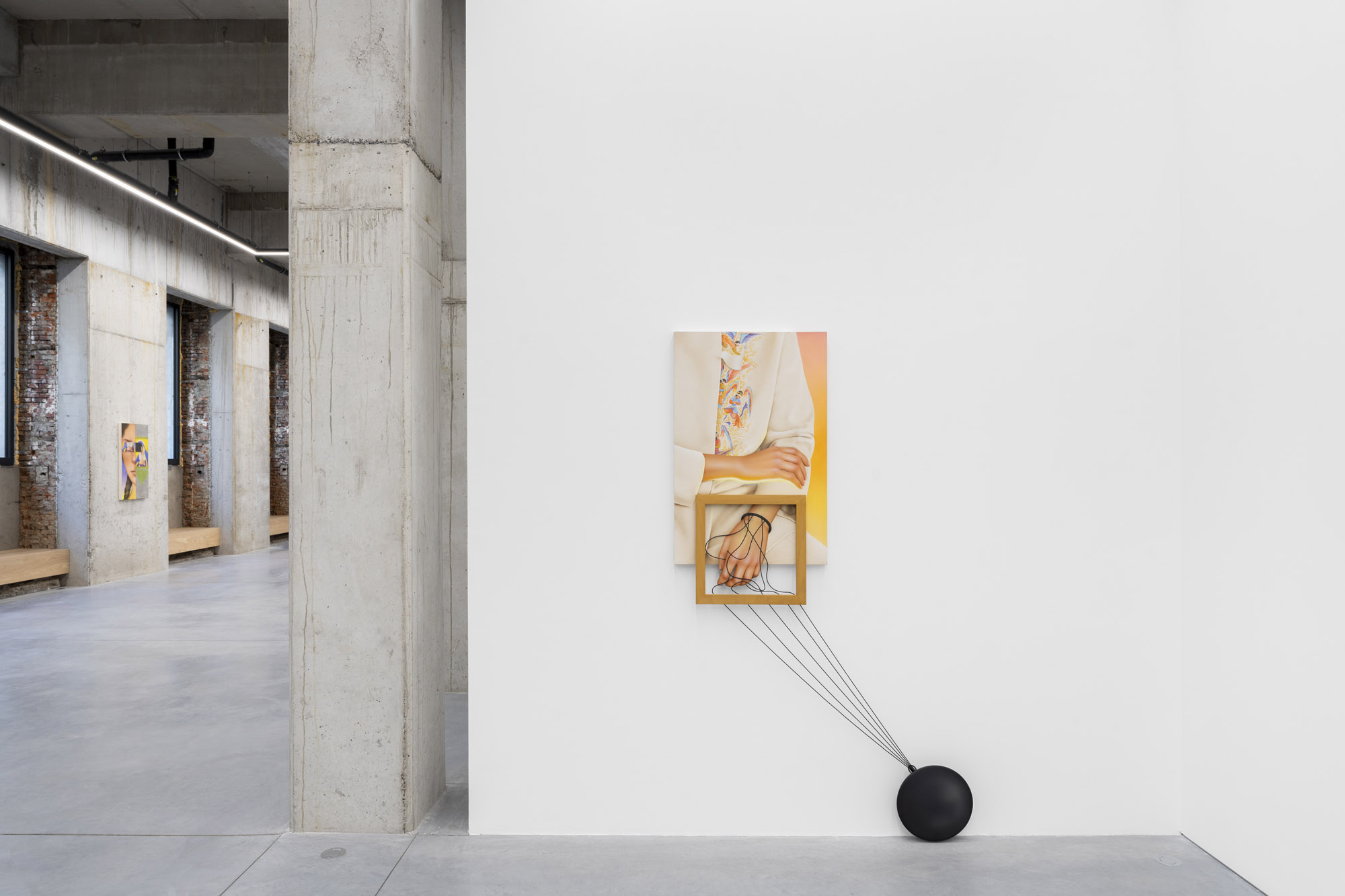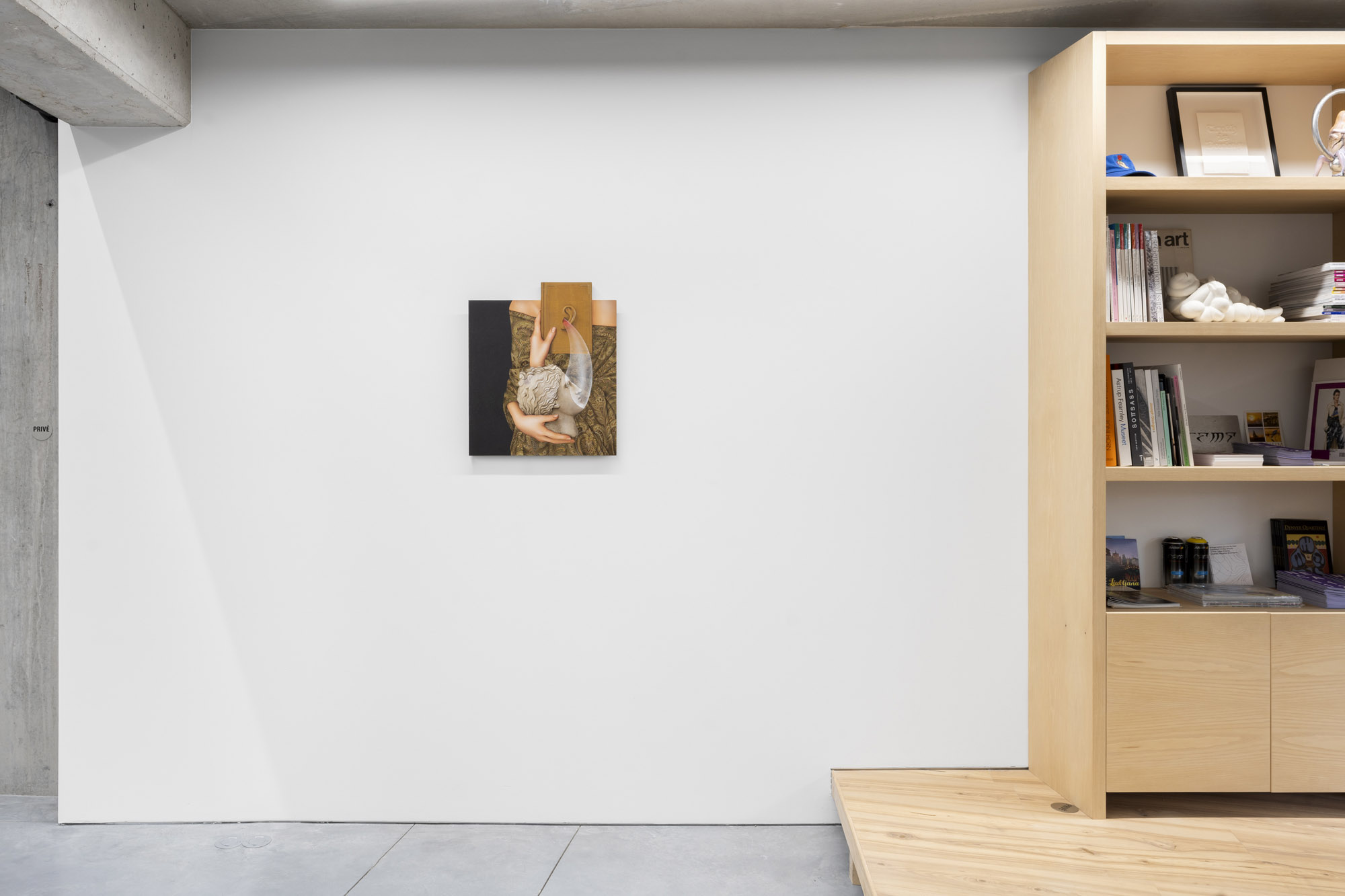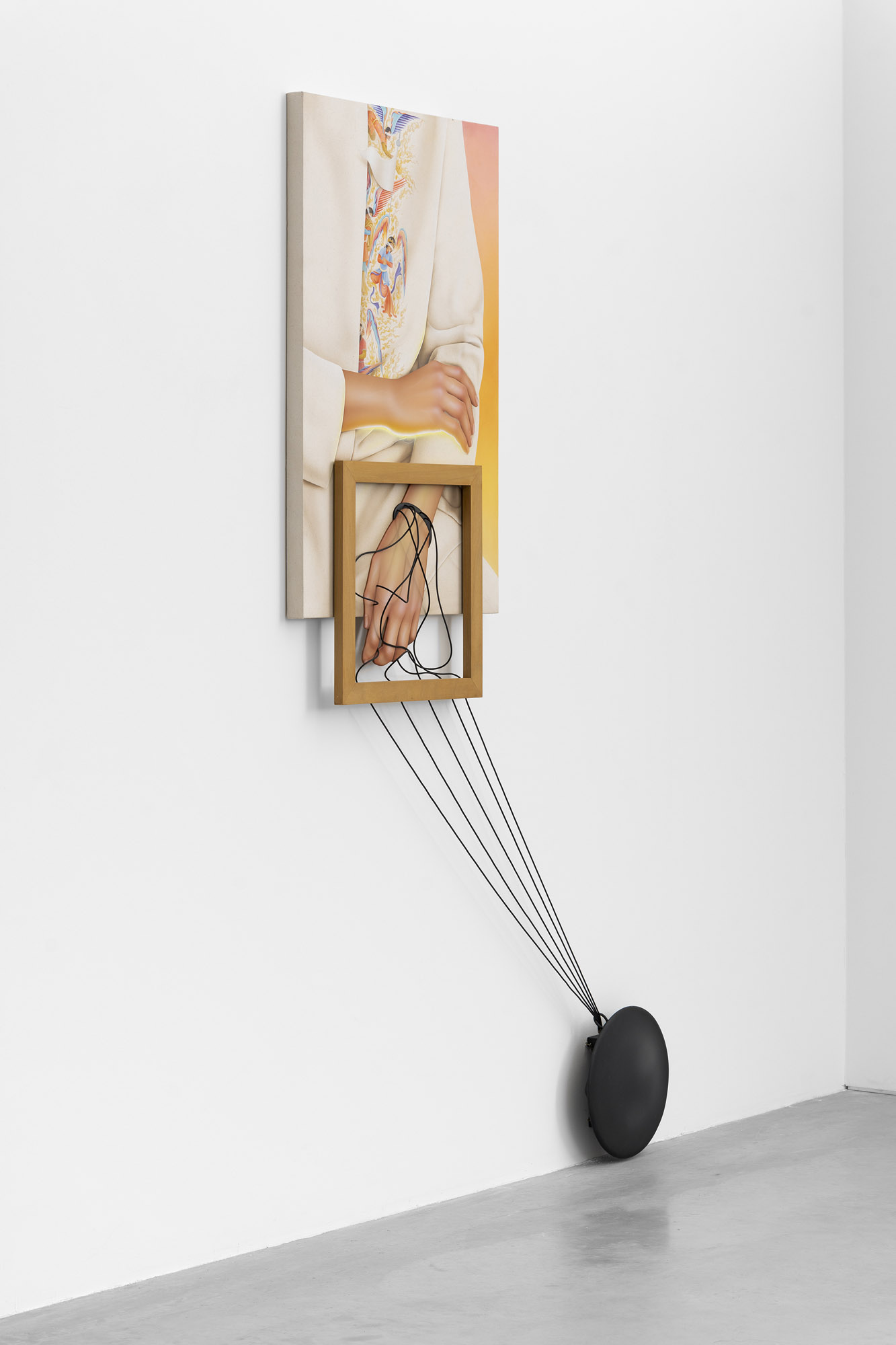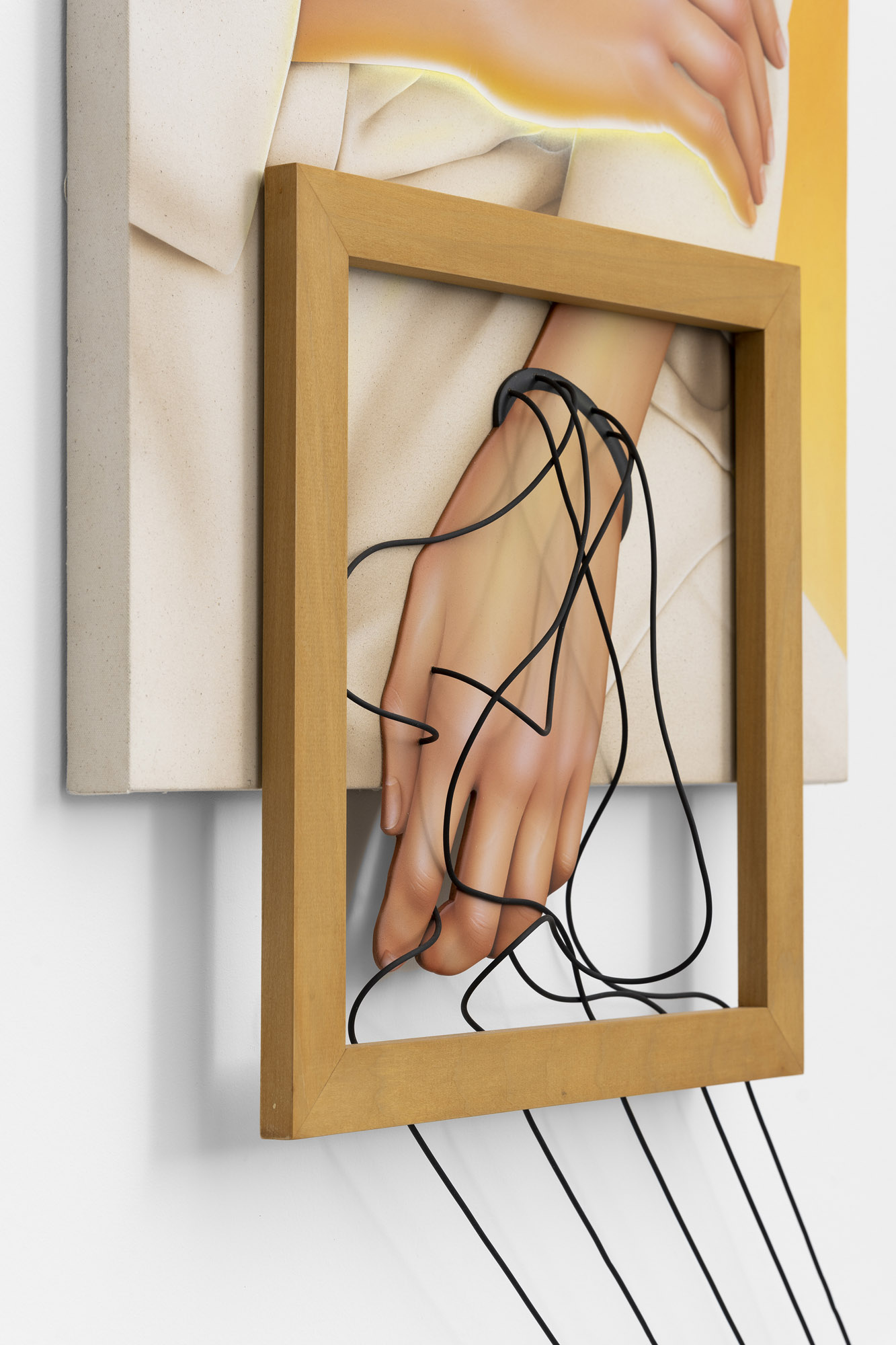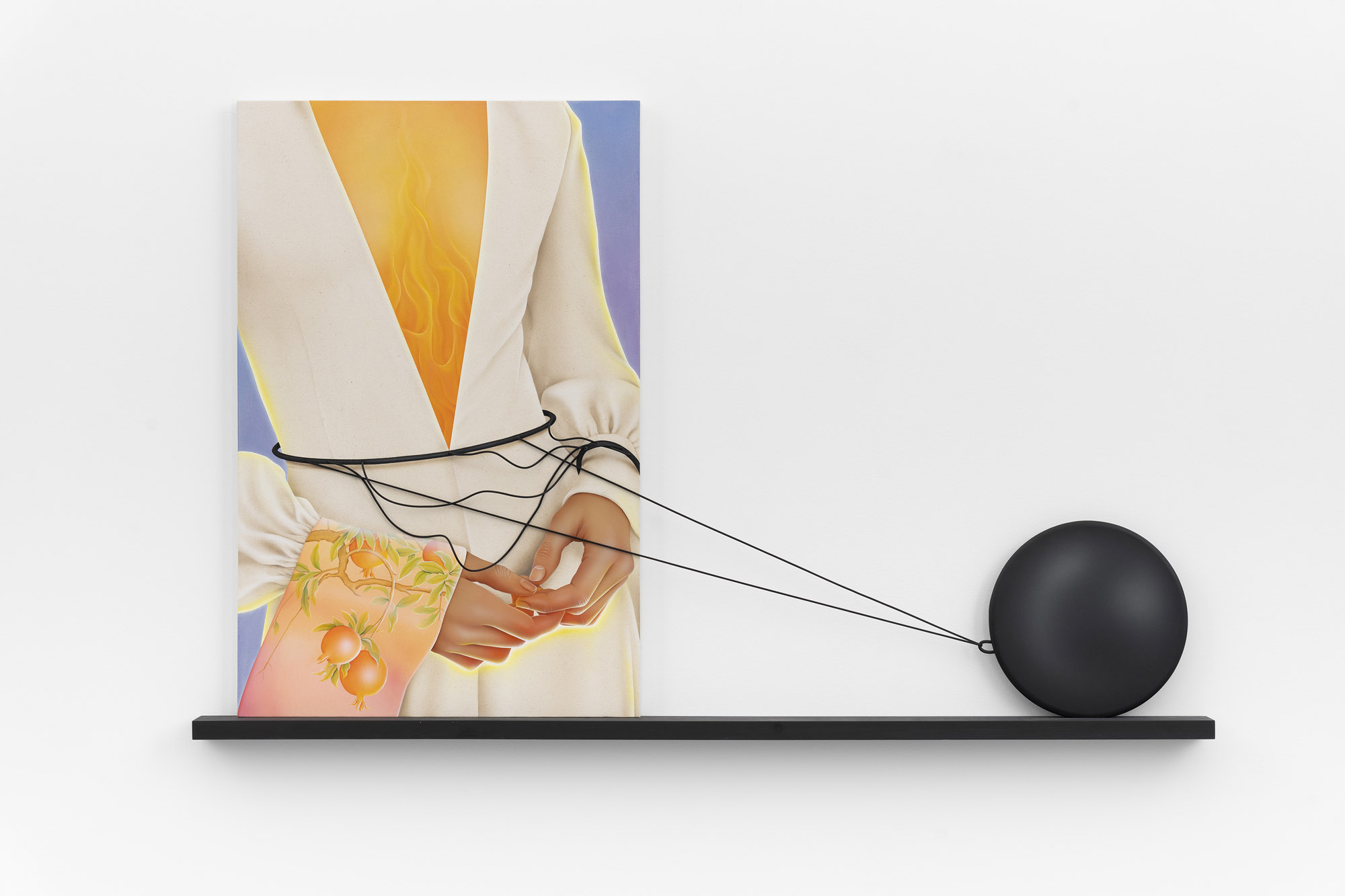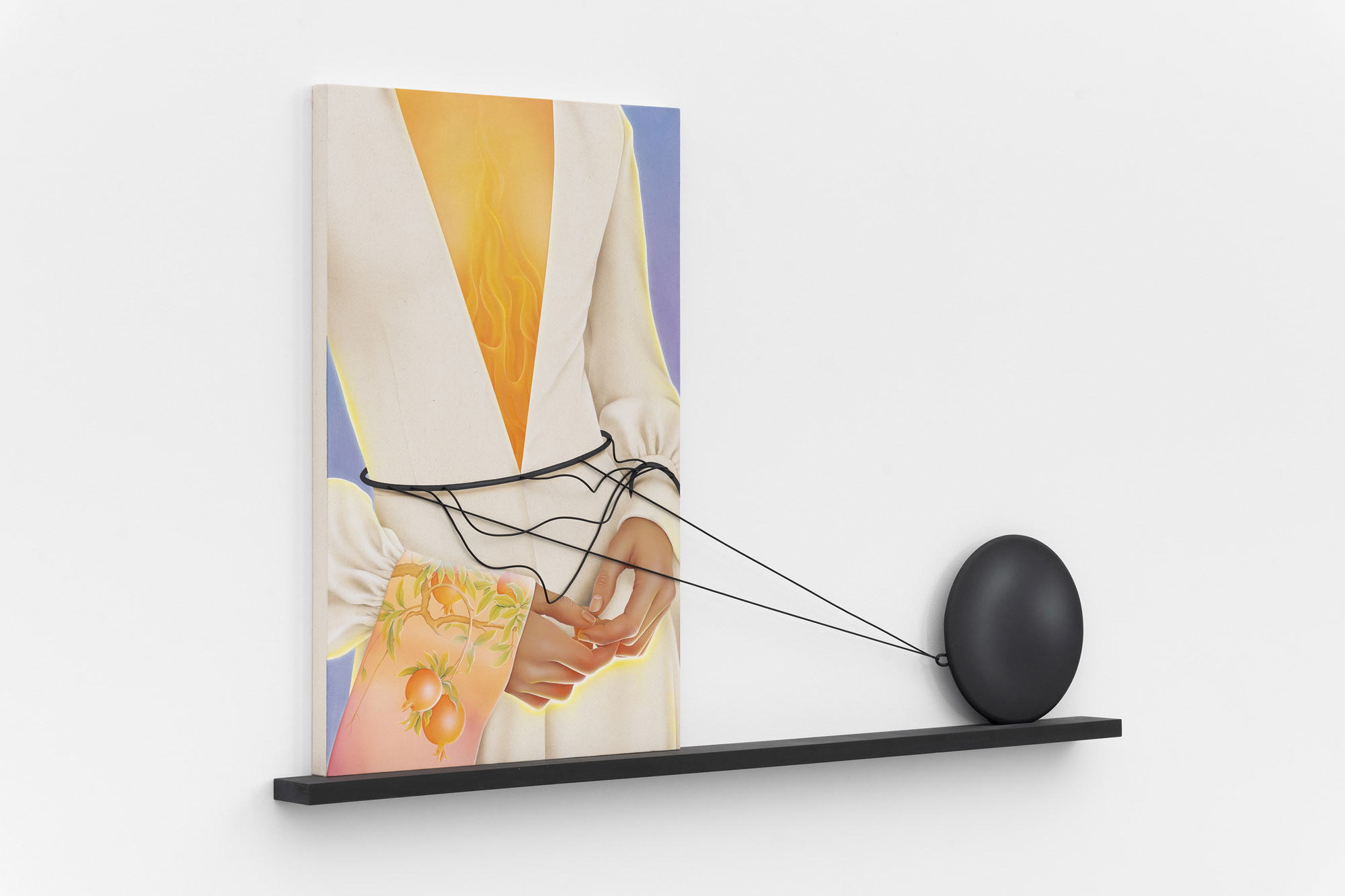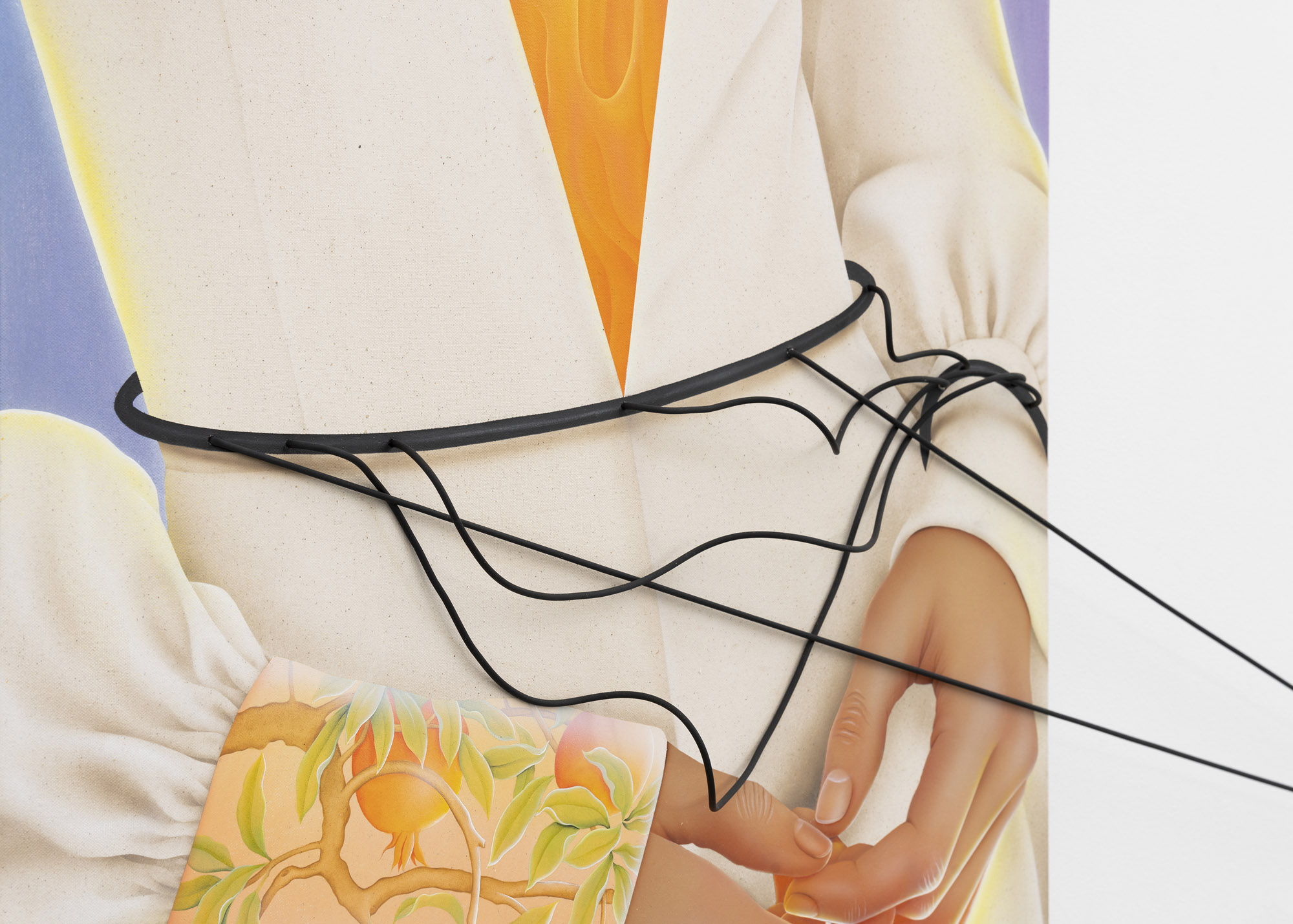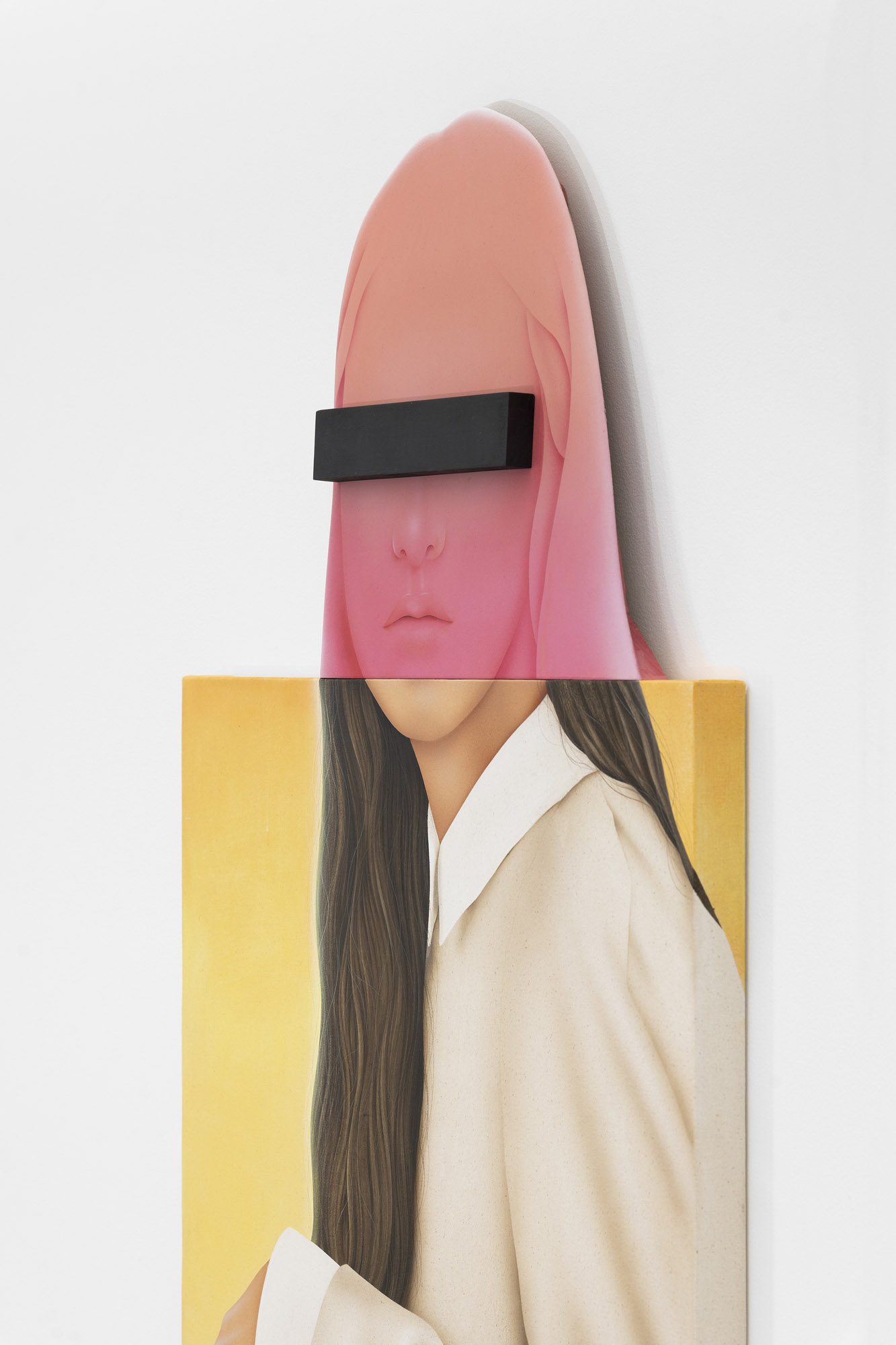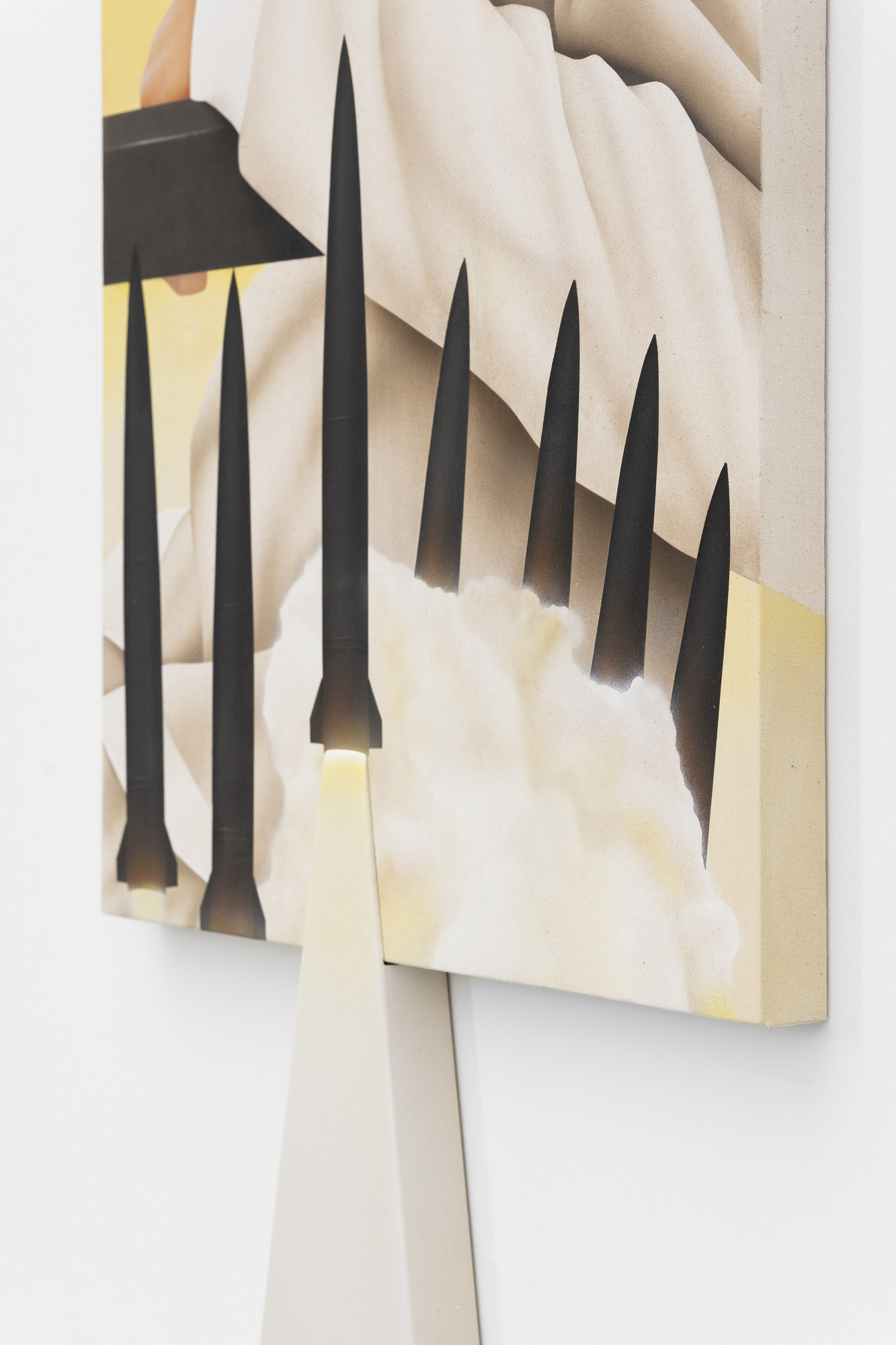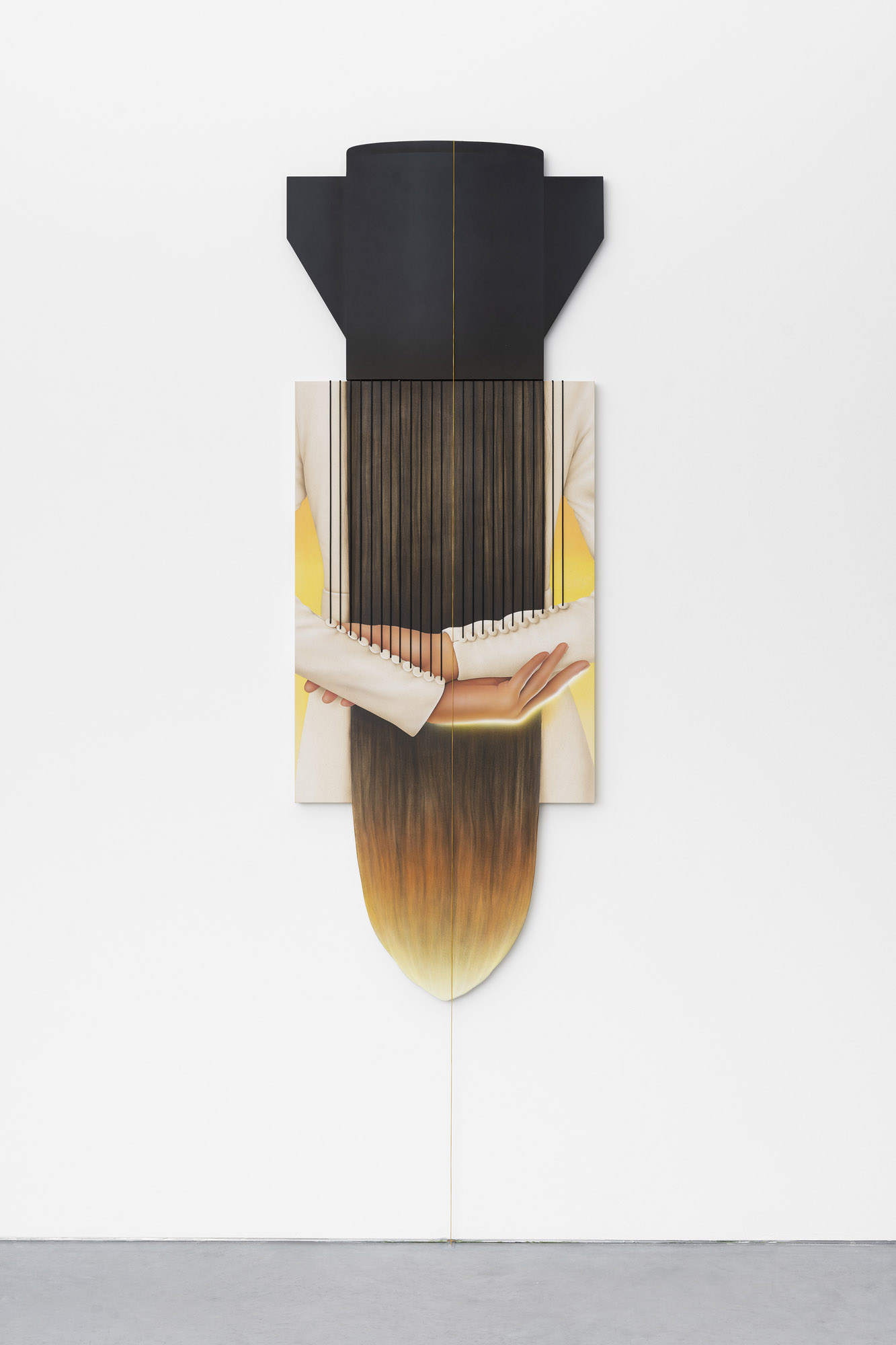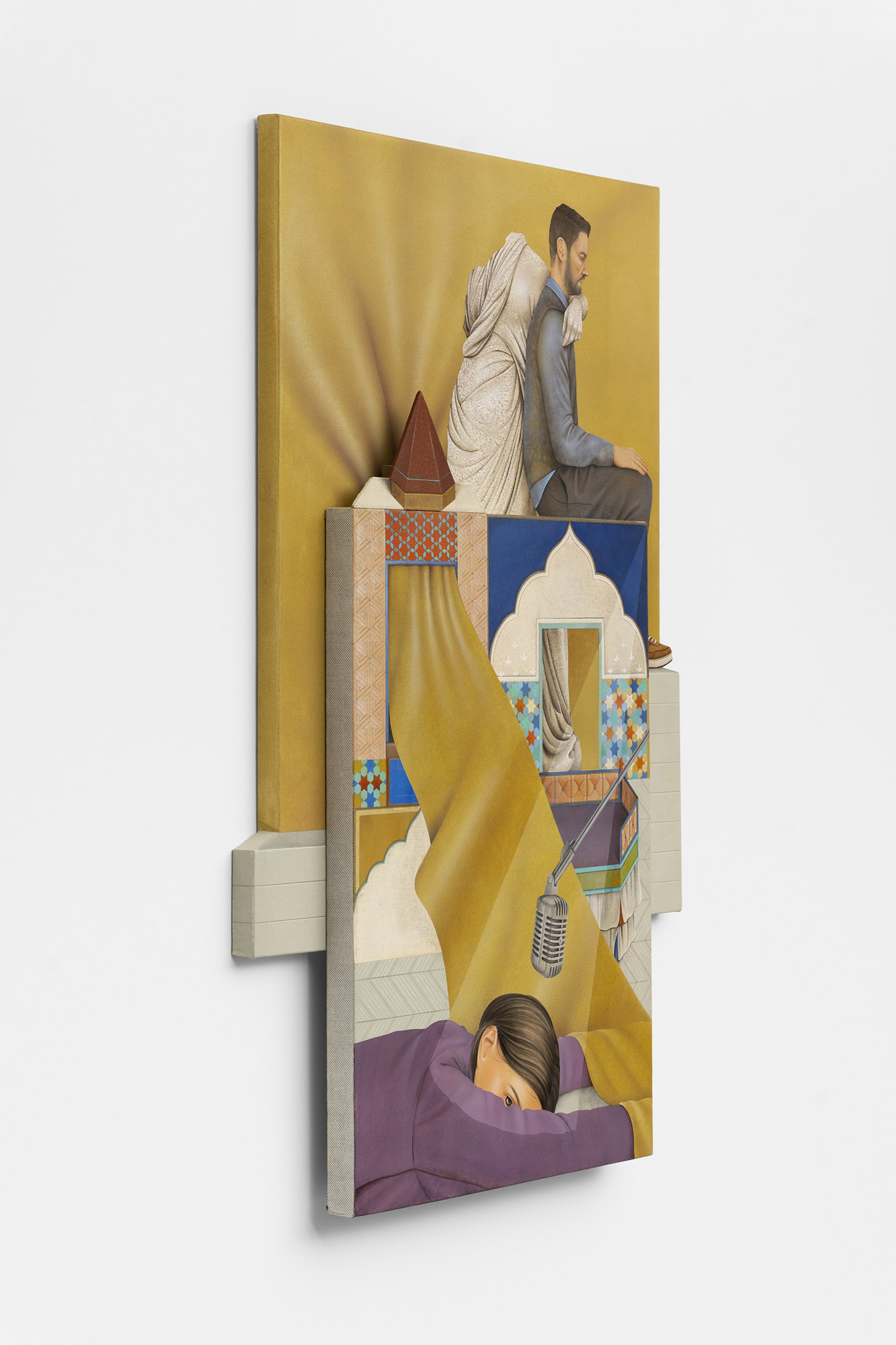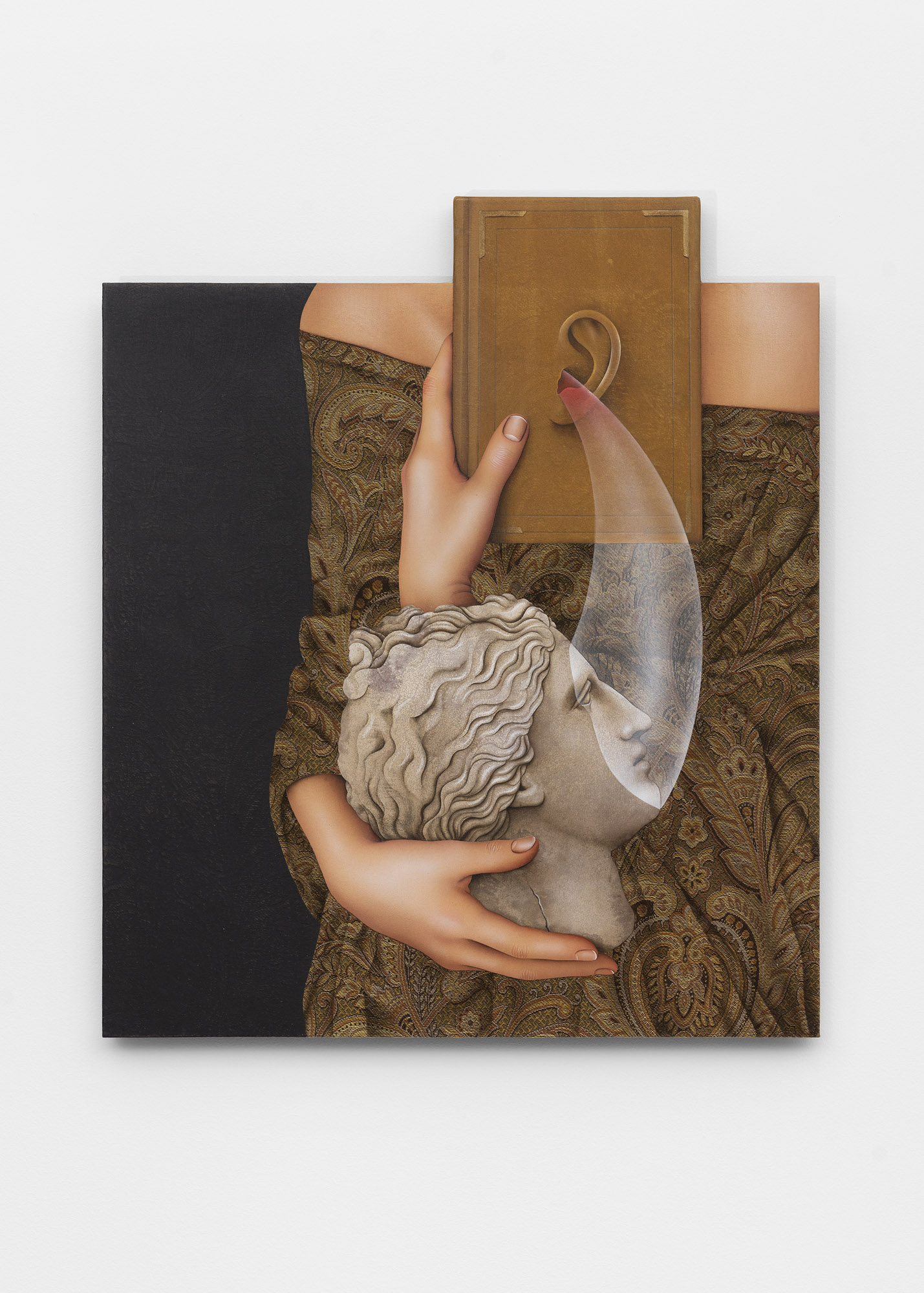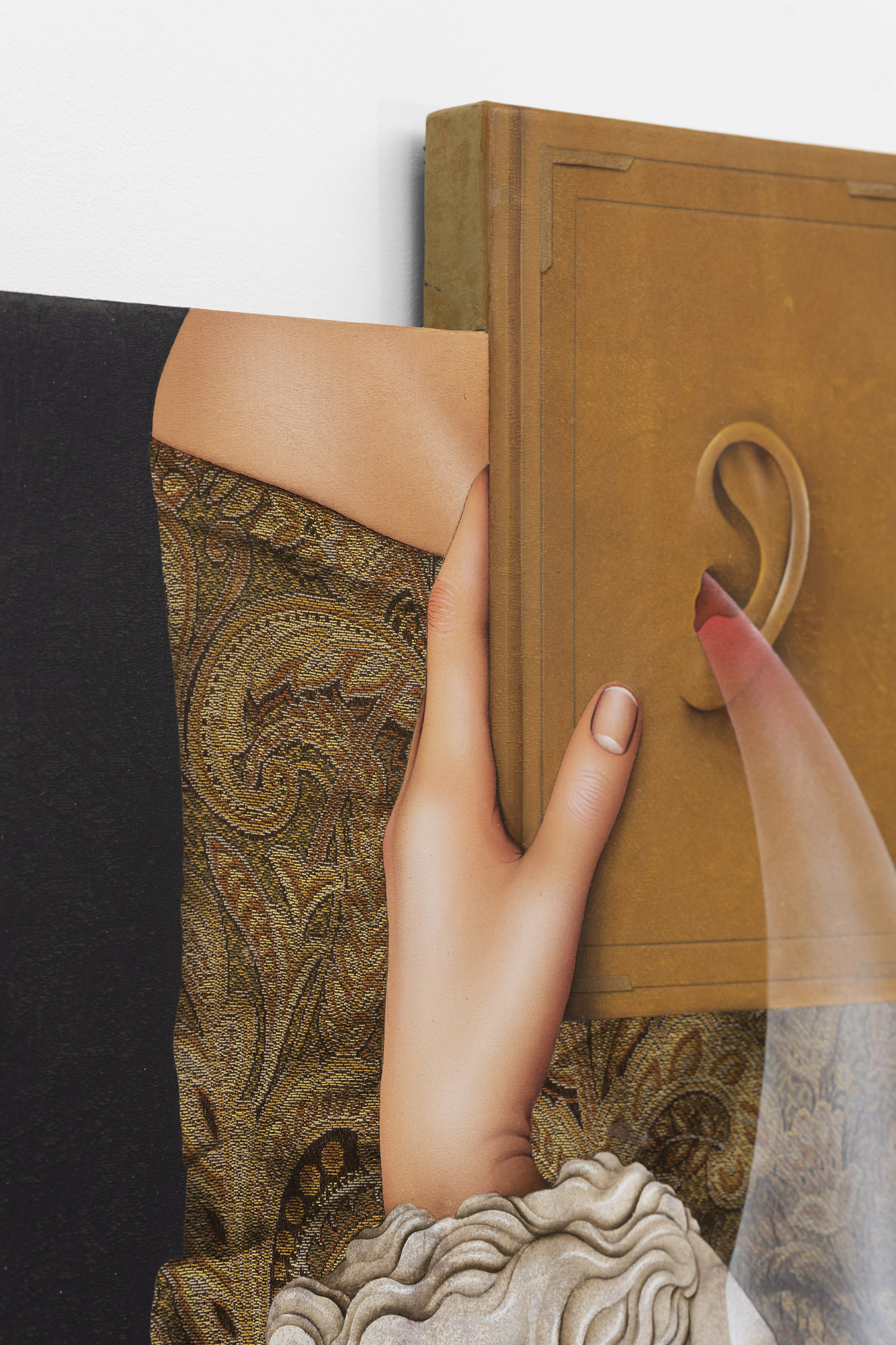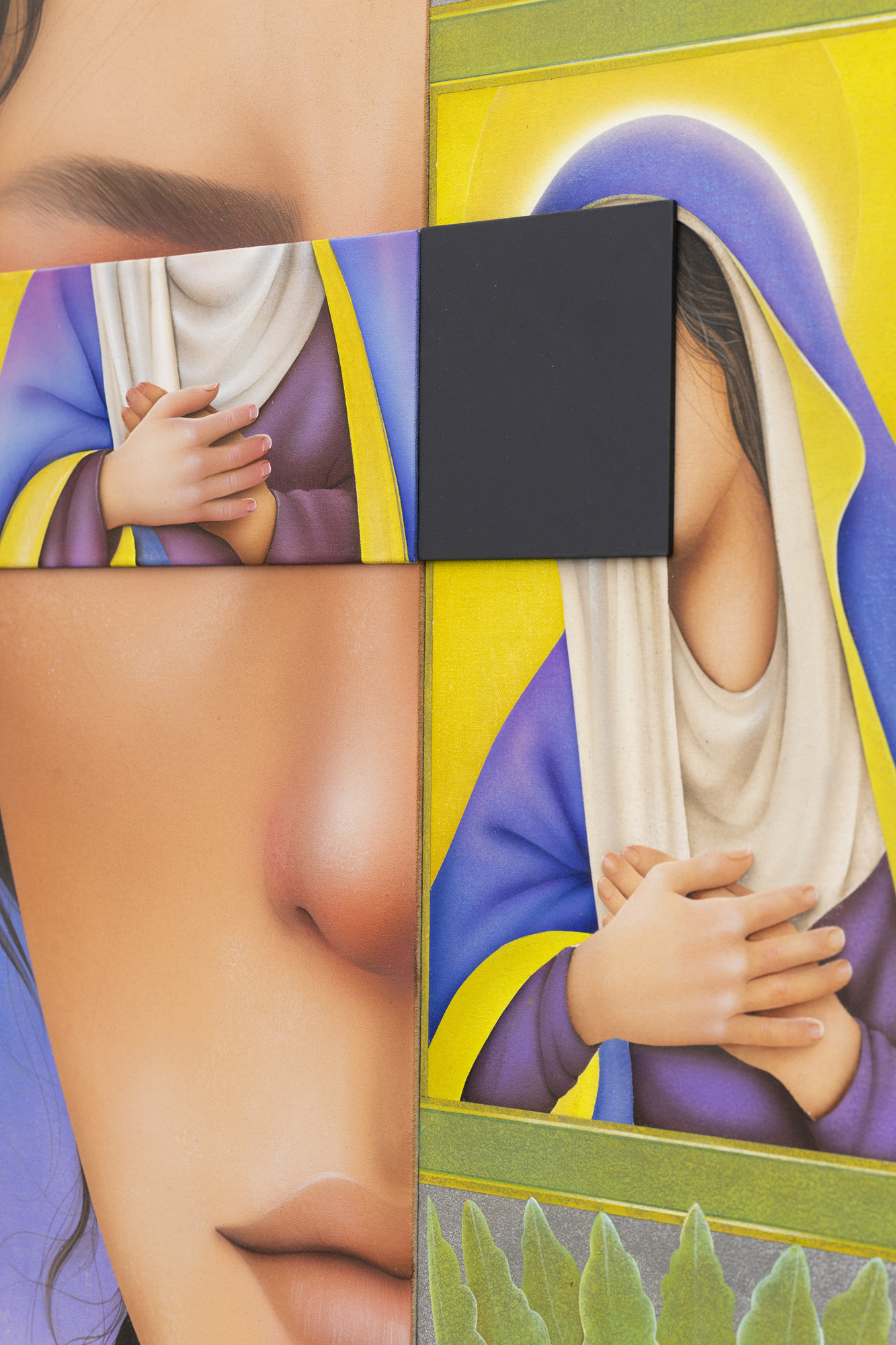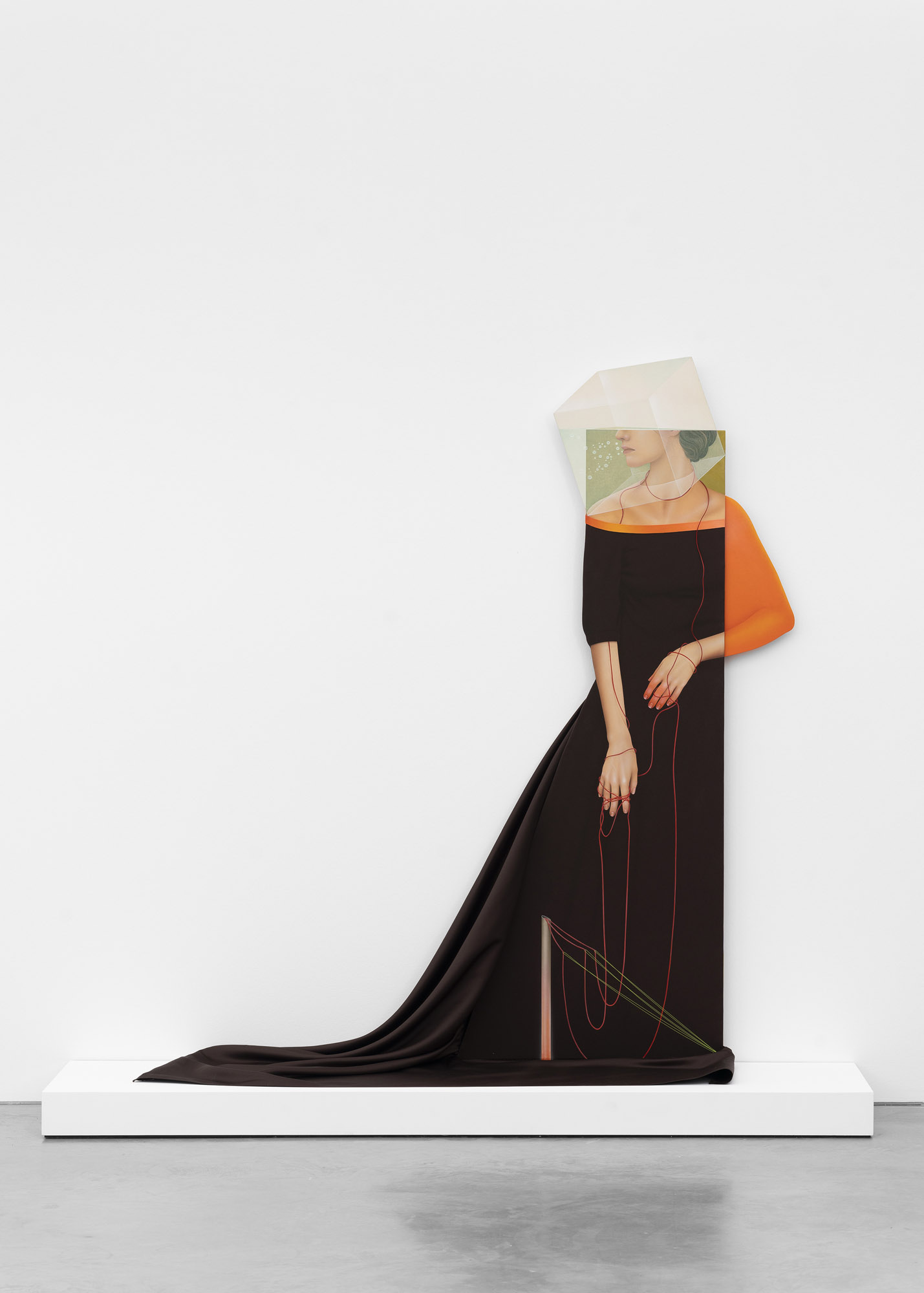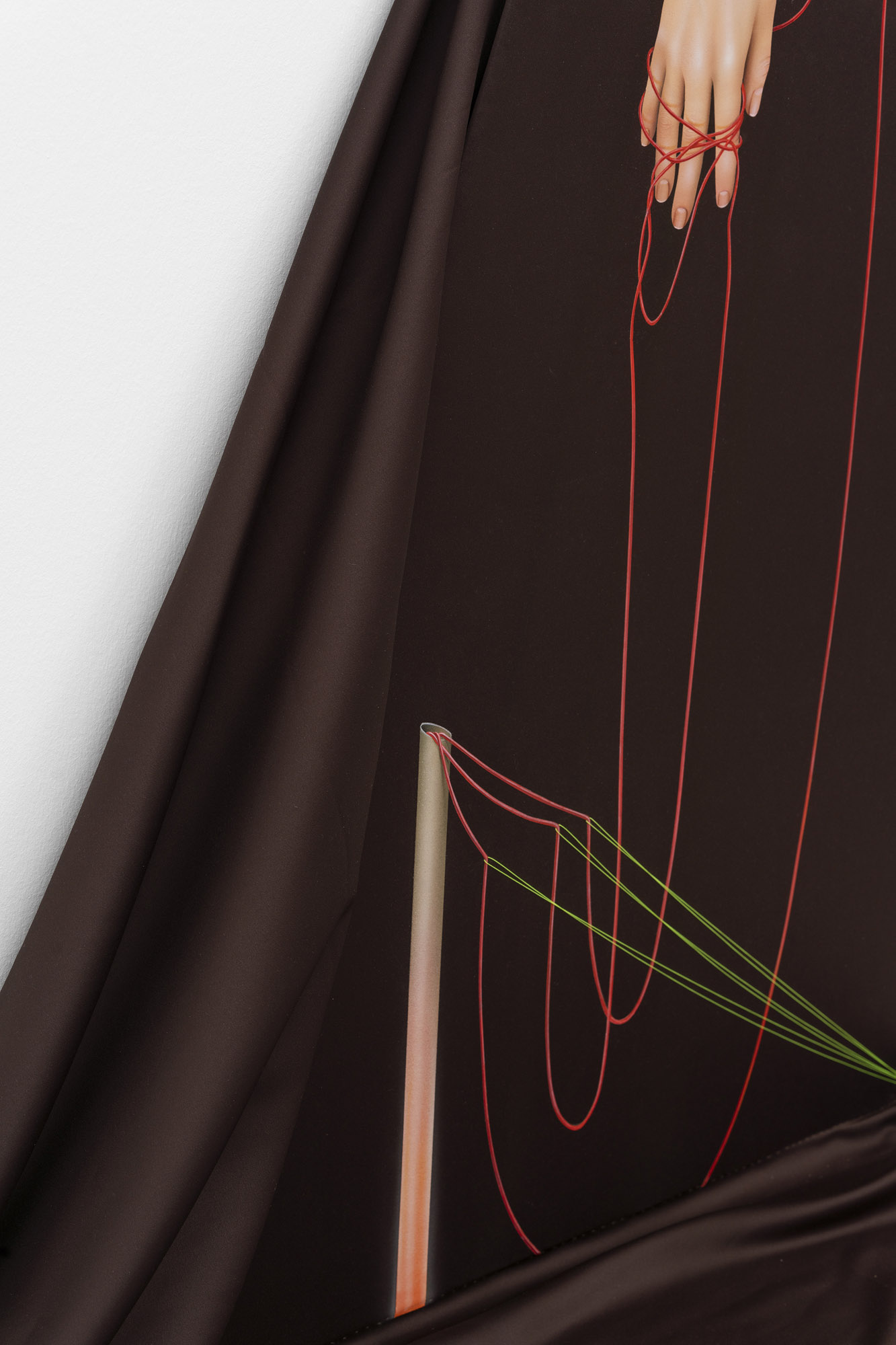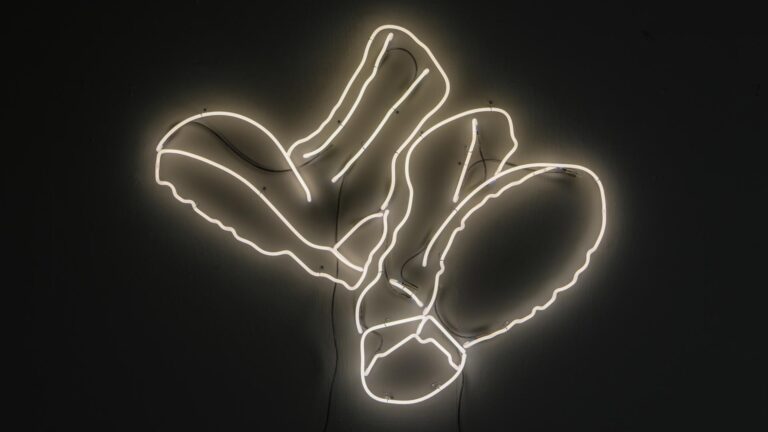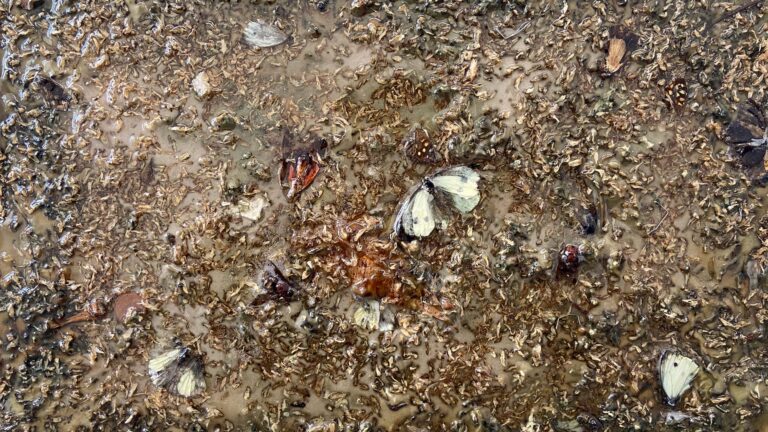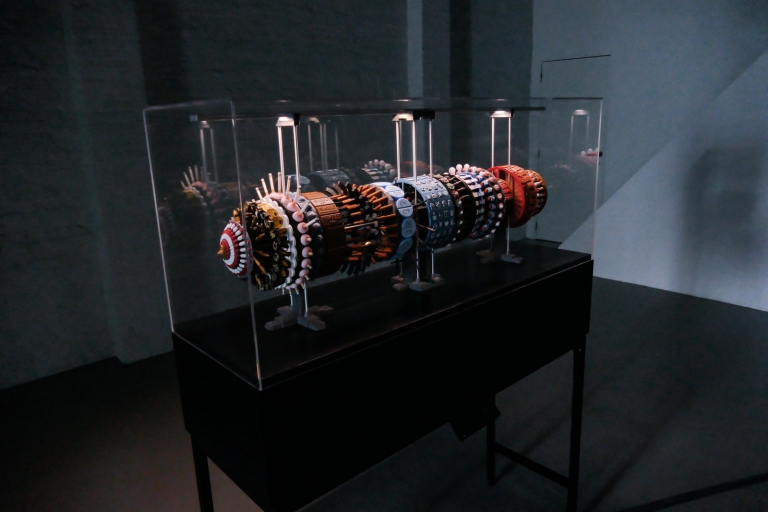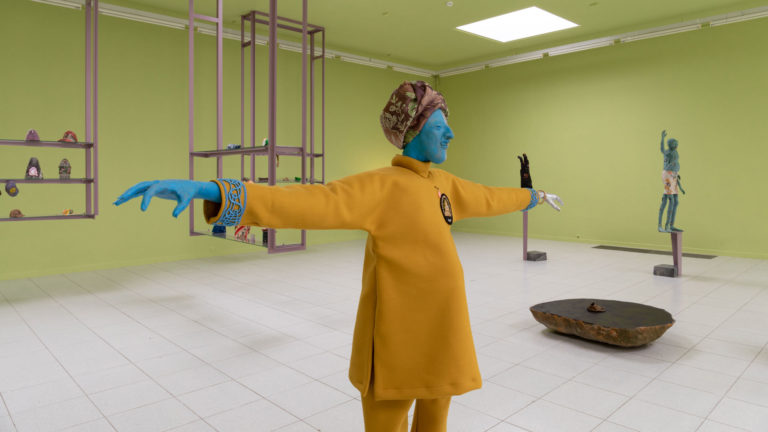Artist: Arghavan Khosravi
Exhibition title: Forced To Be A Saint
Venue: Stems Gallery, Brussels, Belgium
Date: November 17, 2022 – January 28, 2023
Photography: all images courtesy of the artist and Stems Gallery, Brussels
Aesthetic Shifts Between Splendor and Melancholia
Arghavan Khosravi narrates a fraction of the history of Iran—her homeland and a country that has gone through significant sociopolitical unrest over the past four decades. More specifically, she chooses to address the issues of her own gender identity, again in a sociopolitical context, including the constraints imposed by these changes. This land of former glory and splendor, much different from Persia, as envisioned through Scheherazadesque narratives, has regrettably become synonymous with terrorism and has even been labeled as a member of the “Axis of Evil.” Thus, on the one hand, this transition made it difficult for creative minds to remain authentic and find personal means of expression without drowning in the exoticism ordained and adored by the West. On the other hand, Iran’s recurrent presence in news headlines paved the way for Khosravi’s work to gain increased traction in countries distant from such transitional modes of democratization that caused violation and discomposure. This is when and where art, culture, and ontological variances arose: Arghavan’s Persian heritage is intermingled with her Iranian roots and her witty and dynamic character, which outlived her bizarre circumstances, informed her aesthetic narrative.
Khosravi did not need the exoticism that is normally required for visual engagement of international audiences, nor did she intend to enforce an image of Iranian women, as portrayed by the West, and which was formed from Iran’s political upheaval. In fact, this approach had been ongoing for almost two decades, beginning after the first major post-1979 Islamic revolution institutional exhibition titled “Iranian Contemporary Art” at the Barbican Center in 2001. Ever since Rose Issa’s finely curated show turned the heads of the non-Iranian art world toward the modern and contemporary art of present-day Iran before and after the revolution, many Iranian artists (both in Iran and in the diaspora) rode the waves and produced similar absurd and paradoxical imagery of “trendy” cultural topics such as feminism, body culture, and women’s rights issues in developing countries such that their work became the primary representation of Iranian art—not to mention the calligraphic touches frequently added to intensify this oriental exoticism. Additionally, this extrinsic approach was fueled by the imagery produced largely by American and European journalists who visited Iran earlier during Mohammad Khatami’s presidential term (1997–2005). Irrespective of politics, journalists used to do one or two side stories on women, subtly addressing their hijabs, in contrast with Western-oriented settings and social contexts: woman in chador having spaghetti, woman in chador drinking Sprite in front of a mural of the martyrs of the Iran– Iraq war, woman in chador standing in an underground train next to blond girls with nose jobs and heavy makeup in their mandatory but loose headscarves, and other imagery portraying Iranian men and women of the Qajar dynasty in modern settings and vice versa.
As an Iranian woman with her own subjective stories and experiences, Khosravi used her artistic language to express her feelings, both traumatic and gratifying, and lived experiences as a woman who decided to leave her country in her early thirties. Khosravi also aimed to address the longstanding sociopolitical status of the women living under the theocratic regime in her homeland. With her roots of visual culture in Persian Painting and ability to find inspiration in that form of expression as her pictorial source—given that it relates to her experience as a children’s book illustrator— Khosravi succeeded in forming a distinctive language mostly referred to as symbolic and sometimes as surrealistic. We must define, however, the symbolism and surrealism critics have vividly referred to in Khosravi’s body of work, considering their Western definitions and examples. Her choice of subject, for instance, the inner subjectivity and dream imagery (that may be an indicator of Western symbolism in visual arts), are substituted with the metaphoric use of symbolic elements and semiotics to form her critical narrative. Khosravi uses a visual metaphor that highlights Iran’s history of censorship and suppression—that led to the formation of an allegorical language in the arts and literature—and which juxtaposes symbolic settings and symbolism, as seen in Persian Paintings. Together, these aspects embody her aesthetics in a cultural context, and the unique combination makes Khosravi’s work widely accessible and interpretable to a broader audience.
Taking Shahnameh (The Book of Kings written by Ferdowsi between 977 and 1010 CE) as a multidimensional example that helped the post-Islam dynasties understand what it means to be Iranian through visual and storytelling language, Khosravi’s works also play a similar role in identifying what it means for her to be Iranian, the effort most Iranian women artists in the diaspora make as a result of their social and individual contradictory experiences.
In all her works of the past five years, Khosravi has focused on women’s issues, each time via a novel rhetoric using diverse imagery. Although her storylines are intuitively based on actual events, Khosravi’s focus on detail allows for seamless shifts between the many turbulent circumstances affecting women’s lives. For example, in light of recent political uprisings in Iran initially triggered as an opposition against mandatory hijab, hair has become Khosravi’s visual focus, often as a metaphor for gender inequality, in her current series titled Forced to be a Saint.
Through the compelling storytelling of her paintings, expressed through present-day aesthetics, Khosravi pays tribute to women’s strength and perseverance—and this explains why her protagonists are always women. Khosravi’s flattened landscapes, like those in Persian miniatures, juxtaposed against images with rhetorical signification, lead to patched compositions, possibly interpreted as an unorthodox outcome of visual stream of consciousness that is also sometimes identified as surrealistic.
In her recent series, Khosravi highlights another bleak characteristic of living under a chauvinistic theocratic sovereignty: women are constrained within boundaries, as if their basic rights are considered a felony. The black cords in this series, for example, strapped around women’s wrists and waists, symbolize such restraints (e.g., “The Glowing Bird,” “The Pomegranate Sleeve,” and “The Weight”). Also, the black wooden bar covering the woman’s eyes in “Days and Nights” or the square wooden piece placed on the holy woman’s eyes in “Forced to be a Saint”, are used as visual elements that correspond to criminality. Against joyful palettes of bright shades of yellow and orange, these black cords, black wooden shelf-like surfaces, black bars and black weights, exterminate the ecstaticity of the bright colors and guide viewers through the layers of visual and conceptual paradoxes she tends to portray.
As examples of Khosravi’s artistic expression in this series, “The Yellow Sky,” “The Glass Box 2,” and “Untitled” are based on Persian miniatures without human figures. The flat surface of the three works creates an unrealistic ambiance that help imply the paradox Khosravi inclines to reveal, once she adds her realistic human figures and objects. With this contradictory approach, Khosravi not only deconstructs a primary aesthetic characteristic of Persian Painting—the tradition of creating a timeless and placeless work—but also emphasizes her personal emotions lost in this paradox between her social, ethnic, and cultural background, along with her present-day creative life, which was carried on somewhere with different values, habits, and daily routines.
For example, “The Yellow Sky” comprises three multidimensional custom-shaped canvases, including the most significant symbolic element found in Persian Painting: geometric symbols. The juxtaposition of these geometric forms shapes an oriental schematic structure with two semi- realistic human figures that have outgrown the miniscule architectural setup, which denotes a surreal composition, communicating a metaphoric narrative. With this picture, like all the others Khosravi creates, she does not intend for it to resemble an outlined story. Rather, Arghavan makes pastiches based on Persian visual traditions, creating a setting in which human figures and Western objects with specified connotations can be inserted to form narratives. This work, for instance, features a Roman Renaissance sculpture with its hand around a sitting man’s shoulder acting as a backrest. It also features a young woman lying on the floor with her hands underneath a window, which lets in a thick ray of light that flows below a hanging microphone (as if to say that she can make her voice heard). The symbolic use of the window in this work may further explain Khosravi’s visual storytelling approach: windows metaphorically portray the dual life of all Iranians living under a totalitarian regime always distinguishing between their public and private lives. By positioning varied visual elements in a fine oriental architectural setting, Khosravi demonstrates to her audiences her emotional, nostalgic, and nationalistic traits.
Observing Khosravi’s creative practice over the past five years—wherein she has performed as an Iranian woman artist in the diaspora, whose personal life has been significantly affected by the effects of the 1979 Revolution—we can see, in her work, Khosravi also considers her altered cultural take on the paradoxical sociopolitical living standards of her new habitat as an after-effect of migration and displacement. Through this, she reveals an episodic structure with a common thread: the use of storytelling as a cultural and artistic tool to enact change. Khosravi has clearly said this herself, “I’m not interested in perpetuating notions of cultural exoticism and portrayals of Iranian women as victims. Rather, my work is a vehicle for shifting power”1.
-Maryam Majd, Curator, Tehran, November 2022
Arghavan Khosravi, Forced To Be A Saint, 2022, exhibition view, Stems Gallery, Brussels
Arghavan Khosravi, Forced To Be A Saint, 2022, exhibition view, Stems Gallery, Brussels
Arghavan Khosravi, Forced To Be A Saint, 2022, exhibition view, Stems Gallery, Brussels
Arghavan Khosravi, Forced To Be A Saint, 2022, exhibition view, Stems Gallery, Brussels
Arghavan Khosravi, Forced To Be A Saint, 2022, exhibition view, Stems Gallery, Brussels
Arghavan Khosravi, Forced To Be A Saint, 2022, exhibition view, Stems Gallery, Brussels
Arghavan Khosravi, Forced To Be A Saint, 2022, exhibition view, Stems Gallery, Brussels
Arghavan Khosravi, Forced To Be A Saint, 2022, exhibition view, Stems Gallery, Brussels
Arghavan Khosravi, Forced To Be A Saint, 2022, exhibition view, Stems Gallery, Brussels
Arghavan Khosravi, Forced To Be A Saint, 2022, exhibition view, Stems Gallery, Brussels
Arghavan Khosravi, Forced To Be A Saint, 2022, exhibition view, Stems Gallery, Brussels
Arghavan Khosravi, Forced To Be A Saint, 2022, exhibition view, Stems Gallery, Brussels
Arghavan Khosravi, Forced To Be A Saint, 2022, exhibition view, Stems Gallery, Brussels
Arghavan Khosravi, Forced To Be A Saint, 2022, exhibition view, Stems Gallery, Brussels
Arghavan Khosravi, the Weight, 2022, Acrylic on canvas over wood panel, wooden frame, elastic cord, wood cutout, 108 x 61 x 5.7 cm, 42 13/25 x 24 ⅕0 x 2 ¼ in.
Arghavan Khosravi, the Weight, 2022, Acrylic on canvas over wood panel, wooden frame, elastic cord, wood cutout, 108 x 61 x 5.7 cm, 42 13/25 x 24 ⅕0 x 2 ¼ in.
Arghavan Khosravi, the Weight, 2022, Acrylic on canvas over wood panel, wooden frame, elastic cord, wood cutout, 108 x 61 x 5.7 cm, 42 13/25 x 24 ⅕0 x 2 ¼ in.
Arghavan Khosravi, The Pomegranate Sleeve, 2022, Acrylic on canvas over wood panel, wooden shelf, elastic cord, wood cutout, 95 x 152 x 8.9 cm, 37 ⅖ x 59 2½5 x 3 ½ in.
Arghavan Khosravi, The Pomegranate Sleeve, 2022, Acrylic on canvas over wood panel, wooden shelf, elastic cord, wood cutout, 95 x 152 x 8.9 cm, 37 ⅖ x 59 2½5 x 3 ½ in.
Arghavan Khosravi, The Pomegranate Sleeve, 2022, Acrylic on canvas over wood panel, wooden shelf, elastic cord, wood cutout, 95 x 152 x 8.9 cm, 37 ⅖ x 59 2½5 x 3 ½ in.
Arghavan Khosravi, The Glowing Bird, 2022, Acrylic on canvas over wood panel, elastic cord, wood cutout, 101.6 x 92.7 x 6.3 cm, 40 x 36 ½ x 2 ½ in.
Arghavan Khosravi, The Missiles, 2022, Acrylic on canvas over wood panel, wood cutout, 232.4 x 61 x 5.1 cm, 91 ½ x 24 x 2 0 in.
Arghavan Khosravi, The Missiles, 2022, Acrylic on canvas over wood panel, wood cutout, 232.4 x 61 x 5.1 cm, 91 ½ x 24 x 2 0 in.
Arghavan Khosravi, The Missiles, 2022, Acrylic on canvas over wood panel, wood cutout, 232.4 x 61 x 5.1 cm, 91 ½ x 24 x 2 0 in.
Arghavan Khosravi, The Hair, 2022, Acrylic on canvas over wood panel and on shaped wood panel, elastic cord, leather cord, 191.8 x 72.4 x 5.7 cm, 75 5 0 x 28 ½ x 2 ¼ in.
Arghavan Khosravi, The Hair, 2022, Acrylic on canvas over wood panel and on shaped wood panel, elastic cord, leather cord, 191.8 x 72.4 x 5.7 cm, 75 5 0 x 28 ½ x 2 ¼ in.
Arghavan Khosravi, The Hair, 2022, Acrylic on canvas over wood panel and on shaped wood panel, elastic cord, leather cord, 191.8 x 72.4 x 5.7 cm, 75 5 0 x 28 ½ x 2 ¼ in.
Arghavan Khosravi, The Yellow Sky, 2022, Acrylic on canvas and found textile over shaped wood panel, wood cutout, 63.5 x 94 x 5.7 cm, 25 x 37 0 x 2 6/25 in.
Arghavan Khosravi, The Yellow Sky, 2022, Acrylic on canvas and found textile over shaped wood panel, wood cutout, 63.5 x 94 x 5.7 cm, 25 x 37 0 x 2 6/25 in.
Arghavan Khosravi, Untitled, 2022, Acrylic on found textile over shaped wood panel, 55.9 x 48.3 x 2.5 cm., 0 x 19 ⅕0 x 49/50
Arghavan Khosravi, Untitled, 2022, Acrylic on found textile over shaped wood panel, 55.9 x 48.3 x 2.5 cm., 0 x 19 ⅕0 x 49/50
Arghavan Khosravi, Forced To Be A Saint, 2022, Acrylic on canvas over wood panel, wood cutout, 97.8 x 26.7 x 3.8 cm, 38 ½ x 10 ½ x 1 ½ in.
Arghavan Khosravi, Forced To Be A Saint, 2022, Acrylic on canvas over wood panel, wood cutout, 97.8 x 26.7 x 3.8 cm, 38 ½ x 10 ½ x 1 ½ in.
Arghavan Khosravi, The Glass Box (2), 2022, Acrylic on canvas and found textile over shaped wood panel, leather cord, 188 x 149.9 x 5.1 cm, 74 x 59 x 2 in.
Arghavan Khosravi, The Glass Box (2), 2022, Acrylic on canvas and found textile over shaped wood panel, leather cord, 188 x 149.9 x 5.1 cm, 74 x 59 x 2 in.
Arghavan Khosravi, Days and Nights, 2022, Acrylic on canvas over wood panel, wooden bar. Triptyque, 59 x 27.9 x 3.2 cm, 23 23/100 x 10 49/50 x 1 1⅗0 in, 59.7 x 35.6 x 11.4 cm, 23 ½ x 14 ⅕0 x 4 49/100 in, 59.7 x 41.9 x 3.2 cm, 16 ½ x 23 ½ x 1 ¼ in.
Arghavan Khosravi, Days and Nights, 2022, Acrylic on canvas over wood panel, wooden bar. Triptyque, 59 x 27.9 x 3.2 cm, 23 23/100 x 10 49/50 x 1 1⅗0 in, 59.7 x 35.6 x 11.4 cm, 23 ½ x 14 ⅕0 x 4 49/100 in, 59.7 x 41.9 x 3.2 cm, 16 ½ x 23 ½ x 1 ¼ in.

